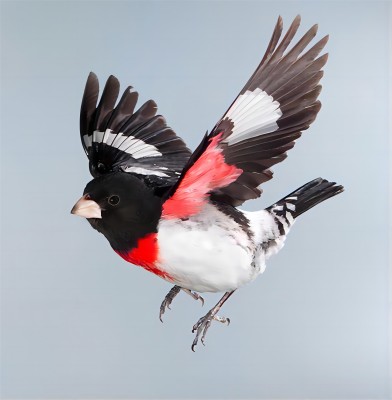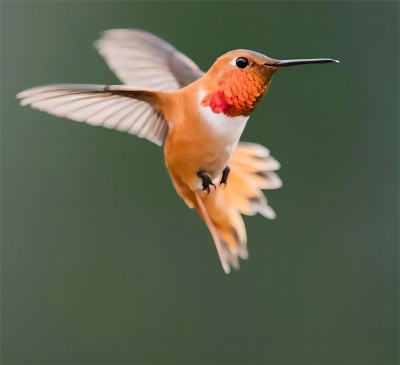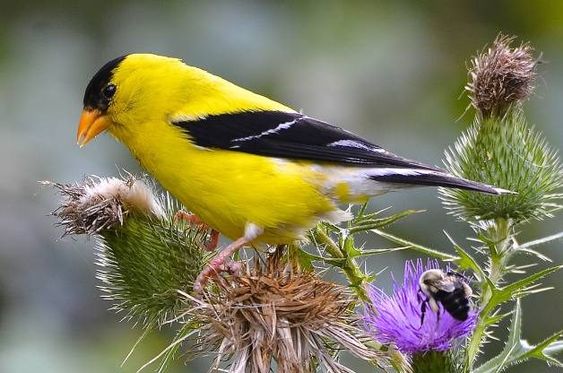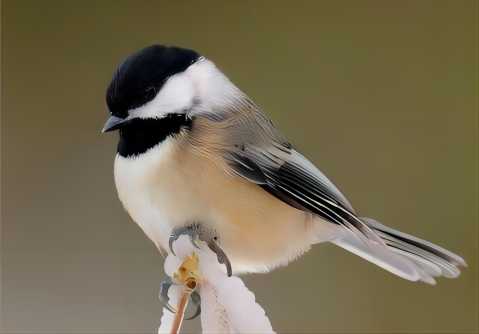The Rose-breasted Grosbeak (Pheucticus ludovicianus) is a striking and charismatic bird species that captivates birdwatchers with its distinctive appearance and melodious song. This medium-sized songbird belongs to the cardinal family (Cardinalidae) and is known for its vibrant plumage and beautiful markings, making it a cherished sight in North American woodlands and gardens.
Physical Characteristics:


- Distinctive Plumage: The male Rose-breasted Grosbeak is easily recognizable by its striking black and white plumage with a splash of rosy-red on its breast, giving rise to its name. In contrast, the female sports a more subtle combination of brown, white, and cream colors.
- Size and Shape: These birds have a robust body, a large conical bill that is adapted for cracking seeds, and a strong, sturdy beak that gives them their name "grosbeak."
- Sexual Dimorphism: The bold color differences between males and females make them easily distinguishable. Males exhibit the characteristic rose-red patch on their breast, while females have a more camouflaged appearance for nesting purposes.
Habitat and Distribution:
- Preferred Habitats: Rose-breasted Grosbeaks are commonly found in deciduous forests, woodland edges, and gardens with ample shrubbery and trees for nesting and foraging.
- Geographical Range: Their breeding range extends across eastern North America, from southern Canada to the northeastern United States, with some populations wintering in Central America.
Behavior and Diet:
- Diet: Rose-breasted Grosbeaks are primarily seed-eaters, with a diet that includes a variety of seeds, nuts, berries, insects, and occasionally fruits.
- Song and Vocalizations: Males are known for their melodious and flute-like songs, which they use to establish territories and attract mates during the breeding season.
- Migration: These birds are long-distance migrants, with populations from the northern parts of their range migrating to Central and South America for the winter months.
Breeding and Nesting:
- Breeding Season: Rose-breasted Grosbeaks typically breed in the spring and early summer months when food sources are abundant.
- Nesting Habits: Females construct cup-shaped nests made of twigs, grasses, and other plant materials, often placed in the fork of a tree or shrub for protection.
- Incubation and Parental Care: Both parents participate in incubating the eggs and caring for the young fledglings, with the male often assisting in feeding duties.
Conservation Status:
- Rose-breasted Grosbeaks are generally considered to be of least concern in terms of conservation status, with stable populations across their range. However, habitat loss and fragmentation pose potential threats to their long-term survival, highlighting the importance of conservation efforts to protect their woodland habitats.
The Rose-breasted Grosbeak's striking appearance, enchanting song, and graceful presence in North American forests make it a treasured symbol of biodiversity and a delight to birdwatchers and nature enthusiasts alike. Observing these beautiful birds in their natural habitats serves as a reminder of the importance of preserving and appreciating the rich diversity of avian life in our ecosystems


 Introduction to Hummingbirds
Introduction to Hummingbirds
 Comprehensive Overview of Spinus tristis (American Goldfinch)
Comprehensive Overview of Spinus tristis (American Goldfinch)
 Comprehensive Overview of the Chickadee
Comprehensive Overview of the Chickadee